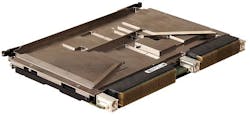GPGPU processors to help with artificial intelligence, machine learning, pattern recognition
NEW ORLEANS – The general-purpose graphics processing unit -- GPGPU for short -- represents perhaps the most revolutionary leap in computer processing capability in decades for aerospace and defense applications. Not only does it offer advanced graphics rendering and massively parallel processing, but its capabilities in artificial intelligence and machine learning also are just being explored.
The GPGPU chip has potentially hundreds of separate processing cores. Originally these were for rendering complex graphics, and later for massively parallel processing. Today they are considered to be artificial intelligence engines; each core can mimic a neuron in the human brain to offer machine learning.
The first benefit of GPGPUs in aerospace and defense applications today was for displays, which are proliferating from the aircraft cockpit to the infantry soldier using wearable computing.
"GPGPUs are doing a lot of the heavy lifting when it comes to displays," says Doug Patterson, vice president of military and aerospace business at Aitech Defense Systems Inc. in Chatsworth, Calif. Patterson made his comments in January at the Embedded Tech Trends (ETT) conference in New Orleans.
Related: HPEC enables onboard data processing for persistent surveillance
Then came parallel processing. "Somebody figured out they were good at single-precision floating point math," says Marc Couture, product manager at Curtiss-Wright Defense Solutions in Ashburn, Va.
It's the parallel-processing that perhaps is most intriguing. "Think about neurons and neural processing, like the Brain," Patterson says. "It's sophisticated pattern recognition."
These devices "use deep learning to about their environment to determine if an object is a threat," Patterson says. Now this deep-learning capability can be ruggedized for aerospace and defense systems.
"GPGPUs are getting good at deep learning," says Curtiss-Wright's Couture. "Within defense, deep learning can be used in UAVs [unmanned aerial vehicles], so instead of humans picking out targets on the grounds, GPGPUs are getting good at doing what humans have done. Deep learning for tactical sensors is faster than a human at picking targets on the ground."
Company information
GPGPU suppliers
AMD Embedded Products
Sunnyvale, Calif. www.amd.com
NVIDIA Corp.
Santa Clara, Calif.
www.nvidia.com
GPGPU board suppliers
Abaco Systems
Huntsville, Ala.
www.abaco.com
ADLINK Technology
San Jose, Calif.
www.adlinktech.com
Aitech Defense Systems Inc.
Chatsworth, Calif.
www.rugged.com
Artesyn Embedded Technologies
Tempe, Ariz.
www.artesyn.com
Asus Computer International Inc.
Fremont, Calif.
www.asus.com
Concurrent Technologies
Woburn, Mass.
www.gocct.com
Curtiss-Wright Defense Solutions
Ashburn, Va.
www.curtisswrightds.com
EIZO Rugged Solutions
Altamonte Springs, Fla.
www.eizorugged.com
Eurotech
Columbia, Md.
www.eurotech.com
Extreme Engineering Solutions (X-ES)
Middleton, Wis.
www.xes-inc.com
Kontron
Poway, Calif.
www.kontron.com
Mercury Systems
Chelmsford, Mass.
www.mrcy.com
Wolf Advanced Technology
Uxbridge, Ontario
wolfadvancedtechnology.com
Learn more: search the Aerospace & Defense Buyer's Guide for companies, new products, press releases, and videos

